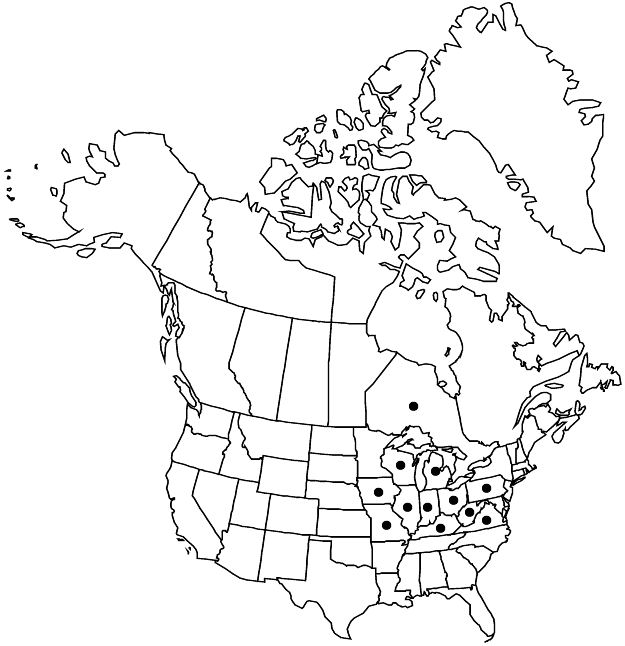Crataegus margarettae
J. Elisha Mitchell Sci. Soc. 16: 72. 1900.
Shrubs, 60–70 dm. Stems: twigs: new growth becoming shiny, brownish tan by fall in 1st year, glabrous, 1-year old brownish gray, older dull gray; thorns on twigs few to numerous, straight to recurved, 1-year old blackish, ± shiny, slender, 2.5–5 cm. Leaves: petiole length 30–60% blade, glabrous, usually with small glands at first, becoming eglandular, glands ± caducous, small; blade green to bluish green, suborbiculate, ovate, or obovate, rarely elliptic-rhombic to elliptic or lance-elliptic, 3–5 cm (less than 2.5 in var. meiophylla), subcoriaceous, base cuneate to broadly cuneate, lobes 1–3(or 4) per side, sinuses usually shallow, sometimes deep, lobe apex obtuse to angled, margins crenate to finely, sharply serrate, veins 3 or 4 per side, apex subacute to obtuse, abaxial surface glabrous, adaxial ± sparsely appressed-short-pubescent young, glabrescent. Inflorescences 6–15-flowered; branches glabrous, rarely pubescent; bracteoles late caducous, linear, subherbaceous, margins glandular. Flowers (8–)12–17 mm diam.; hypanthium glabrous; sepals narrowly triangular, 4–5 mm, margins entire or subentire, glandular, abaxially glabrous; stamens 20, anthers ivory; styles 2 or 3(or 4). Pomes yellow, orange-red, red, or dull burgundy, broadly ellipsoid to suborbicular, 7–12 mm diam., glabrous; sepals reflexed, often on collar; pyrenes 2–4. 2n = 34.
Distribution

c, e North America.
Discussion
Varieties 4 (4 in the flora).
Crataegus margarettae is widespread and often common, extending east from Missouri and Iowa to Wisconsin, southern Michigan, southwestern Ontario (where it was always rare and is now perhaps lost), western Pennsylvania, and western Virginia.
Leaves of Crataegus margarettae are often somewhat blue-green at maturity, and the thorns are usually finer than found on its close relatives C. dodgei and C. lumaria. The variation in fruit color (yellow to burgundy) and leaf shape (suborbiculate to narrowly elliptic) is considerable; there are four varieties but only the typical one is common. The other varieties are extreme forms of which perhaps only var. angustifolia has a genetic basis; var. brownii and var. meiophylla are possibly products of dry seasons or situations.
Selected References
None.
Lower Taxa
Key
| 1 | Leaf blades proportionately narrow, lance-elliptic or oblong-lanceolate, bases cuneate, lobes (0 or obscure), sinuses shallow, apices acute. | Crataegus margarettae var. angustifolia |
| 1 | Leaf blades proportionately wide, broadly elliptic, obovate to ovate, suborbiculate, or round, bases broadly cuneate, lobe sinuses ± shallow to ± deep, apices obtuse to subacute | > 2 |
| 2 | Flowers 8–10 mm diam.; pomes ellipsoid. | Crataegus margarettae var. brownii |
| 2 | Flowers 12–17 mm diam.; pomes broadly ellipsoid to suborbicular | > 3 |
| 3 | Leaf blades 3–5 cm, broadly elliptic to suborbiculate. | Crataegus margarettae var. margarettae |
| 3 | Leaf blades less than 2.5 cm, round. | Crataegus margarettae var. meiophylla |